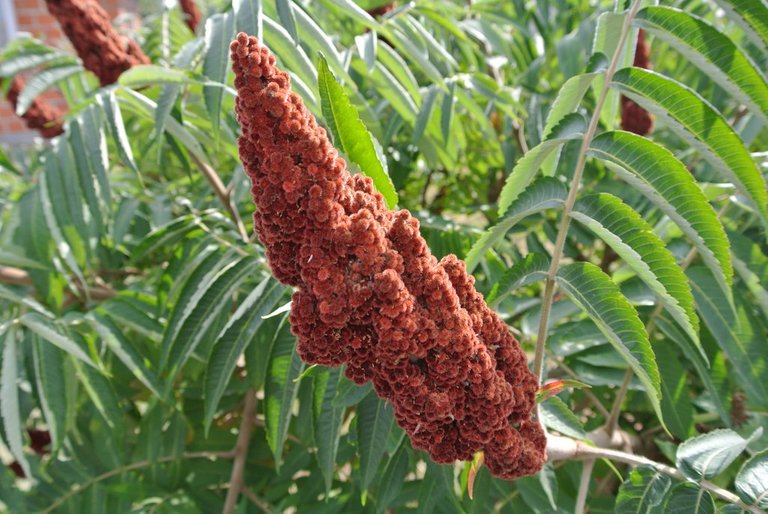
This is Staghorn sumac (lat. Rhus typhina) whose photo I took in nearby garden.
'According to wikipedia.org, Staghorn sumac (lat. Rhus typhina) is
'a dioecious, deciduous shrub or small tree growing up to 5 m (16 ft) tall by 6 m (20 ft) broad. The fruit of sumacs are edible. They can be soaked and washed in cold water, strained, sweetened and made into a pink "lemonade" sometimes called "Indian lemonade". The drink extract can also be used to make jelly. The shoots can be peeled and eaten raw. The leaves and berries of staghorn sumac have been mixed with tobacco and other herbs and smoked by Native American tribes. This practice continues to a small degree to this day. All parts of the staghorn sumac, except the roots, can be used as both a natural dye and as a mordant. The plant is rich in tannins and can be added to other dye baths to improve light fastness. The leaves may be harvested in the summer and the bark all year round.''
'According to eattheplanet.org, Staghorn sumac (lat. Rhus typhina) is
'an ancient medicinal plant with antioxidant properties, and significant levels of Vitamin C. Native Americans used Sumac to treat colds, sore throats, fever, infections, diarrhea, dysentery and scurvy. Sumac has also been used to treat asthma and cold sores. It also lowers blood sugar, as it has hypoglycemic properties and can aid in diabetes management. Ground berries mixed with clay created a salve used on open wounds, and Sumac berries are also used in smokers by beekeepers.''
This photo is taken in city Prijedor, in Republic of Srpska, Bosnia and Herzegovina.
Photo is mine property and is shot with my micro 4/3 digital camera Nikon 1 J1.
You can use this photo for commercial purposes. No attribution required.
Congratulations @sasha.antich! You have completed the following achievement on the Hive blockchain and have been rewarded with new badge(s) :
Your next target is to reach 500 upvotes.
You can view your badges on your board and compare yourself to others in the Ranking
If you no longer want to receive notifications, reply to this comment with the word
STOPCheck out the last post from @hivebuzz:
Hello @sasha.antich, please look and read this post:
https://peakd.com/hive-141827/@theherbalhive/sourcing-your-information-a-vital-part-of-ethical-blogging
I've read that and followed (1) example, and don't understand whats wrong with this post now?
does this mean that I can't quote parts of text from other websites in any way?
It is not that it is wrong. The idea is that when you copy someone else's text, you cite the author, and make a comment or brief analysis of what you are quoting, not just copy and paste and say the source or where you are getting that information from.
For example, you can place the copied text in quotation marks, once you finish that text, you proceed to make your personal contribution, interpreting, commenting, saying some experience related to what you are reviewing. If you don't enclose the text in quotation marks, readers will be lost as to which information is from another author and which is yours; I don't know if I'm making myself clear.
The idea is that you, as a content creator, give your personal contribution or interpretation of what you bring from another author, that enriches your post and for sure you will bring us great ideas by doing so.
It is always nice and interesting to read your opinions, experiences and ways of seeing the world.